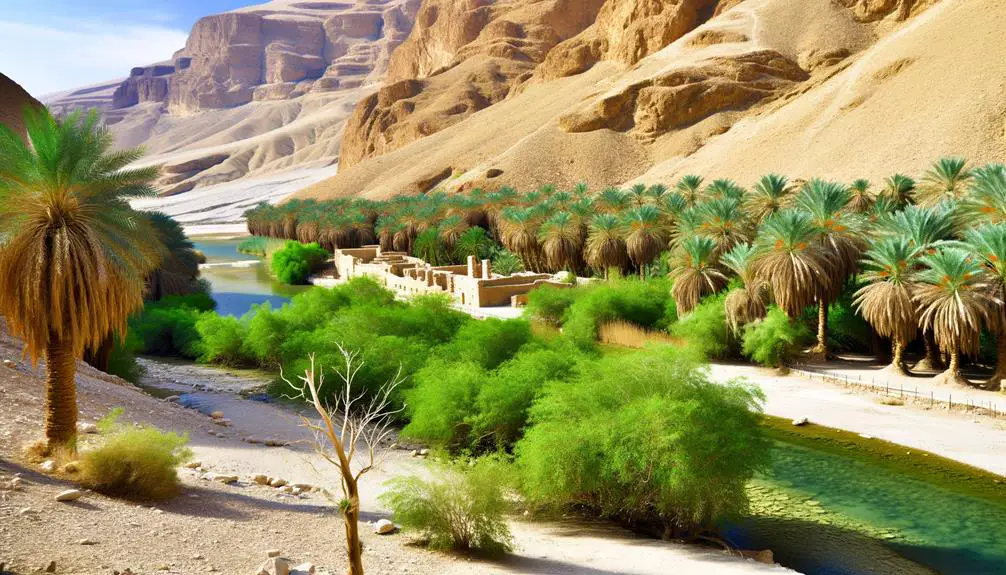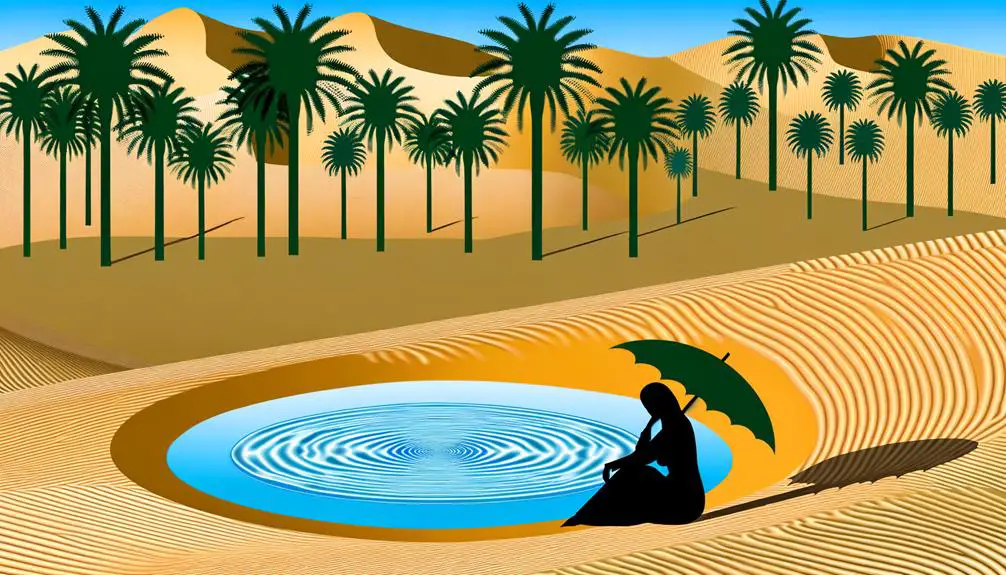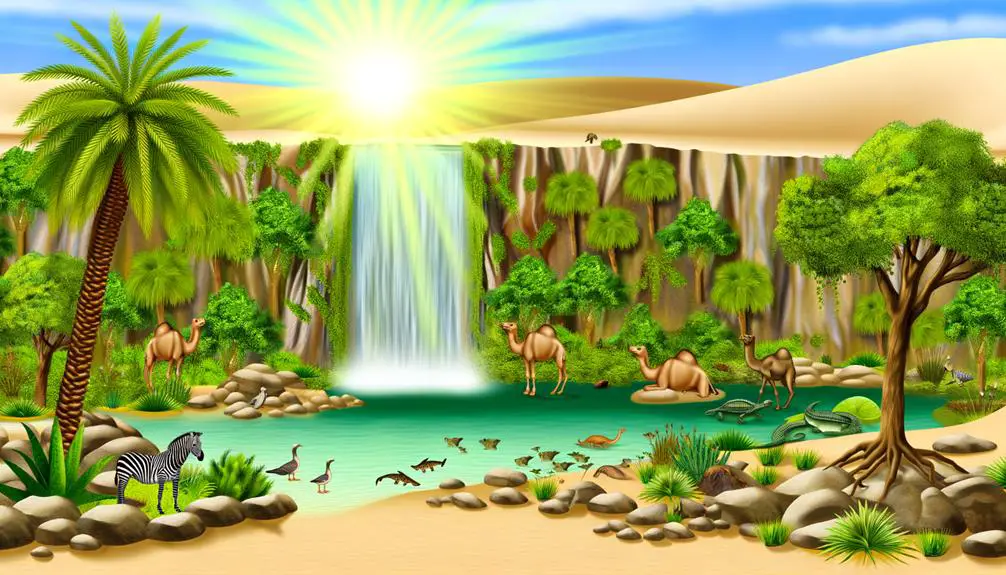Plunge into the depths of En Gedi's biblical symbolism, where ancient tales of refuge and beauty beckon for a deeper exploration.

Meaning of En Gedi in the Bible
When you think of En Gedi in the biblical context, you might recall its mention as the lush oasis where David hid from King Saul, as narrated in the Book of Samuel. This real-life haven in the Judean Desert not only offered physical refuge but also stands as a powerful symbol of divine provision and protection.
Its significance, however, stretches beyond this narrative, weaving through the verses of the Song of Solomon and embodying themes of beauty, sustenance, and restoration. As you reflect on its multifaceted role, consider how En Gedi's ancient springs might still speak to contemporary quests for spiritual sanctuary.
Key Takeaways
- En Gedi symbolizes divine protection and provision in the wilderness.
- It represents an oasis of love and spiritual renewal in the Song of Solomon.
- The oasis showcases nurturing and sustaining love in barren conditions.
- En Gedi serves as a spiritual refuge and site for personal growth and rejuvenation.
Historical Context of En Gedi

Nestled amidst the rugged wilderness of the Judean Desert, En Gedi's strategic location and lush oasis have played a pivotal role in its historical significance since ancient times. This area, characterized by its stark contrast to the surrounding arid landscape, has been a magnet for human settlement and activity for millennia. The climate here, a unique blend of desert dryness with a touch of oasis humidity, has fostered a rich biodiversity that supported ancient communities.
Archaeological discoveries in En Gedi have unveiled insights into its past inhabitants and their ways of life. Excavations have brought to light remnants of ancient cultivation, irrigation systems, and settlements that paint a vivid picture of a thriving community adept at leveraging its environment. These findings underscore En Gedi's role not just as a place of natural beauty, but as a hub of agricultural innovation and economic activity in the ancient world.
The climate of En Gedi, harsh yet nurturing due to its oasis, has shaped its history profoundly. The ability to sustain agriculture in such an unforgiving landscape speaks volumes about the ingenuity and resilience of its ancient dwellers. This oasis served as a critical resource in the midst of the desert, offering relief and sustenance to travelers and inhabitants alike.
Analyzing En Gedi's historical context, it's clear that its geographical and climatic conditions significantly influenced its development. The archaeological evidence underscores its importance as a cultural and economic center in the ancient Judean Desert, illustrating how humans have adapted to and thrived in challenging environments throughout history.
En Gedi as a Place of Refuge

Throughout history, En Gedi has served as a sanctuary, offering refuge to those fleeing adversity in the harsh terrains of the Judean Desert. This oasis isn't just a place of physical respite but also a beacon of hope, symbolizing protection and survival against all odds.
The significance of En Gedi as a place of refuge can be attributed to several key factors:
- Geological Features: En Gedi's unique geological features have made it a natural fortress. Its cliffs and caves provided perfect hideouts for those escaping dangers, while its springs offered essential water sources in the arid desert. This combination of natural defenses and resources made En Gedi an ideal refuge.
- Wildlife Sanctuary: Beyond its geological advantages, En Gedi also flourished as a wildlife sanctuary. The diversity of its flora and fauna added another layer of sustenance for its refugees. The area's rich biodiversity not only provided food but also contributed to the serene environment that soothed many weary souls.
- Strategic Location: Situated near the Dead Sea, En Gedi's strategic location made it accessible yet sufficiently isolated, preventing easy pursuit by those who might wish harm upon its refugees. This balance between accessibility and seclusion contributed significantly to its reputation as a safe haven.
In analyzing En Gedi's role as a place of refuge, it's clear that its geological features, status as a wildlife sanctuary, and strategic location collectively forged a sanctuary amidst the wilderness. For many, En Gedi was more than a mere stopover; it was a symbol of divine protection and provision, offering a glimmer of hope in the face of despair.
Symbolism in Song of Solomon

In the Song of Solomon, En Gedi serves as a powerful symbol of an oasis of love and spiritual refreshment.
You'll find that its mention underscores the lush, fertile nature of love that's both sustaining and rejuvenating.
This imagery not only enriches the text's romantic and spiritual dimensions but also anchors its messages in the tangible beauty of the natural world.
Oasis of Love
En Gedi, as depicted in the Song of Solomon, symbolizes an oasis of love, underscoring the lush, life-giving nature of romantic affection within its poetic verses. This vivid imagery not only captivates your imagination but also serves as a metaphor for the thriving of love in a challenging environment.
Consider the following aspects:
- Desert Romance: En Gedi stands as a testament to love flourishing in the most barren conditions, mirroring how true affection thrives despite adversities.
- Ecological Balance: It underscores the importance of nurturing and sustaining love, akin to maintaining an oasis in the desert.
- Symbolic Richness: The oasis represents a haven of peace and love, providing a stark contrast to the surrounding wilderness, emphasizing the power and sanctuary that love offers.
Spiritual Refreshment Symbol
Diving into the Song of Solomon reveals how En Gedi symbolizes spiritual refreshment, offering a profound metaphor for finding solace and rejuvenation in one's faith amidst life's deserts. This imagery of desert renewal serves as a powerful reminder of the transformative power of spiritual belief.
The references to En Gedi, with its springs and lush gardens in a barren landscape, use hydration imagery to illustrate the essence of divine love and grace. It's as if the text suggests that just as water revitalizes the parched earth, so too can spiritual faith reinvigorate the soul.
This analysis underscores the importance of seeking and embracing spiritual sources of strength, which act as an oasis in the challenging journey of life.
The Story of David and Saul

Exploring the story of David and Saul unveils a pivotal chapter in biblical history, where tensions and dynamics of power, betrayal, and divine providence intertwine at En Gedi. This desert oasis becomes the backdrop for a tale of pursuit and escape, highlighting two key elements: the cave hideout and unexpected mercy.
- Cave Hideout: En Gedi serves as a crucial refuge for David. Pursued by King Saul, who seeks his life out of jealousy and fear, David finds solace and strategic advantage in the labyrinthine caves of En Gedi. This setting isn't just a physical hideout but symbolizes a place of spiritual retreat and contemplation for David, providing him with the clarity and fortitude needed for the challenges he faces.
- Unexpected Mercy: The encounter between Saul and David within the confines of a cave in En Gedi epitomizes the theme of mercy triumphing over vengeance. David, presented with a perfect opportunity to kill Saul, instead chooses to cut off a piece of Saul's robe as proof of his presence and his decision to spare Saul's life. This act of clemency deeply impacts Saul, leading to a temporary reconciliation between the two.
- Divine Providence: The narrative underscores the belief in divine providence guiding the lives of those who remain faithful. David's restraint and his refusal to harm the Lord's anointed despite personal risk reflect his deep trust in God's timing and justice.
En Gedi's Spiritual Significance

Beyond its role as a physical refuge, En Gedi embodies profound spiritual symbolism in the biblical narrative, serving as a testament to faith, renewal, and divine protection. In the harsh realities of the desert, where survival seems improbable, En Gedi emerges as a place of sustenance and hope. This oasis, with its lush vegetation and refreshing springs, stands as a tangible representation of divine provision in the midst of desolation. It's a vivid illustration of how, even in life's metaphorical deserts, miracles aren't just possible; they're a promise.
As you delve deeper into the layers of En Gedi's spiritual significance, you encounter a theme of divine encounters. It's not merely a place where physical needs are met but a setting for profound spiritual renewal and encounters with the divine. Here, amidst the backdrop of natural beauty and survival against the odds, individuals are drawn closer to the divine, experiencing transformation and renewed faith. The narrative of En Gedi reminds you that places of refuge are often more than shelters from physical danger; they're sacred spaces where divine encounters foster spiritual awakening and growth.
In essence, En Gedi's significance in the biblical context transcends its physical attributes, symbolizing a deeper spiritual journey. It represents a divine promise of protection, provision, and presence, even in the most challenging circumstances. Through desert miracles and divine encounters, En Gedi becomes a beacon of hope, illustrating the profound ways in which faith and divine guidance can manifest in one's life, offering renewal and protection in the most unexpected places.
Reflections on Divine Provision

Reflecting on En Gedi's spiritual significance, it's clear that the concept of divine provision plays a pivotal role in understanding this biblical oasis. In the midst of desolation, where survival seems improbable, the existence of En Gedi serves as a powerful symbol of hope and sustenance. It's a vivid illustration of how divine provision can manifest in the least expected places, offering relief and refuge to those in need.
To further understand this concept, consider these three points:
- Desert miracles: En Gedi, with its springs in the desert, exemplifies the idea of desert miracles – instances where aid and abundance spring forth in the midst of scarcity. It's a testament to the belief that, even in the direst circumstances, sustenance and support can be found, often surpassing human expectations.
- Provision principles: The narrative of En Gedi introduces key principles of divine provision, including faith, gratitude, and stewardship. It teaches that recognizing and appreciating these unexpected blessings requires a heart of faith, acknowledging them as signs of divine care and intervention.
- Contextual symbolism: Beyond its historical and geographical significance, En Gedi symbolizes the broader theme of divine provision in life's deserts. It reminds you that in periods of spiritual drought and personal challenge, there's always an oasis of grace, if you're open to recognizing it.
In essence, En Gedi's story isn't just about physical sustenance but also about spiritual nourishment. It encourages a deeper reflection on how divine provision surfaces in your life, often in forms and places you least expect.
En Gedi in Modern Interpretation

You'll find that En Gedi's relevance extends far beyond its historical and biblical roots into contemporary spiritual discourse. Its symbolism as an oasis isn't just a relic of the past but continues to offer profound insights into the nature of spiritual refuge and sustenance today.
This modern interpretation invites you to reconsider En Gedi's spiritual significance in a world that thirsts for meaning and sanctuary.
Spiritual Significance Today
In modern interpretations, En Gedi serves as a powerful symbol of spiritual refuge and rejuvenation, resonating deeply with contemporary faith communities. This historical oasis embeds itself in the narrative of desert spirituality and sacred geography, offering profound lessons:
- Resilience in Adversity: En Gedi's thriving in a desert landscape exemplifies spiritual endurance amidst life's challenges.
- Sacred Space for Solitude: It highlights the importance of finding sacred spaces for contemplation and connection with the divine.
- Renewal and Growth: Just as En Gedi flourishes in harsh conditions, it symbolizes the potential for personal growth and spiritual renewal even in difficult times.
Analyzing En Gedi through these lenses enriches our understanding of its timeless spiritual significance, providing a contextual and authoritative perspective on its place in modern faith narratives.
Oasis Symbolism Revisited
Building on the spiritual significance of En Gedi, let's explore how its symbolism as an oasis offers deeper insights into its role in modern interpretations.
In a world grappling with water scarcity, En Gedi's lushness amidst the desert becomes a powerful metaphor for hope and sustenance. It's not just a historical or biblical reference; it's a contemporary beacon, reminding you of nature's resilience and the human spirit's capacity to find refreshment even in the harshest conditions.
This oasis challenges the desert mirage narrative, offering a tangible touchstone for faith and perseverance. Analyzing En Gedi today invites a reflection on resource management and environmental stewardship, urging a reevaluation of what constitutes true sustenance and survival in our modern landscape.
Frequently Asked Questions
How Has the Flora and Fauna Around En Gedi Changed From Biblical Times to the Present Day?
You've noticed significant shifts in En Gedi's ecosystem from biblical times to today. Modern conservation efforts have been pivotal in maintaining its unique biodiversity, despite the challenges of climate change and human activity.
Agricultural techniques have drastically evolved, allowing for sustainable cultivation without depleting natural resources. These advances ensure En Gedi remains a vibrant oasis, preserving its flora and fauna for future generations while adapting to the demands of the present.
Are There Any Specific Archaeological Discoveries in En Gedi That Have Reshaped Our Understanding of Its Biblical Significance?
Absolutely, recent archaeological finds in En Gedi have deeply impacted our view of its historical and biblical importance.
Ancient inscriptions unveiled there shed light on the community's culture and beliefs, while discoveries related to defense strategies offer insights into how inhabitants protected this oasis.
These findings not only enrich our understanding of daily life in En Gedi but also highlight its strategic and cultural significance throughout history.
How Has the Climate Around En Gedi Evolved Over the Centuries, and What Impact Has This Had on Its Historical and Biblical Narrative?
When push comes to shove, you'll find that the climate around En Gedi has drastically shifted over centuries. This evolution has significantly impacted its historical narrative, necessitating innovative climate adaptation strategies.
Modern irrigation methods, for instance, have played a pivotal role in sustaining the area's agriculture and livelihoods. Analyzing these changes offers a glimpse into how societies adapt to environmental challenges, underscoring the resilience and ingenuity of human civilization in the face of climate variability.
In What Ways Have Different Religious Traditions Outside of Christianity and Judaism Interpreted or Valued En Gedi?
You'll find that En Gedi's significance transcends Christian and Jewish traditions. In Islamic references, it's often highlighted for its historical and spiritual resonance, reflecting a shared heritage with Abrahamic faiths.
Cultural symbolism also plays a huge part; for many, it symbolizes an oasis of peace and spiritual refuge.
Analyzing its impact, it's clear En Gedi serves as a bridge, connecting diverse religious traditions through its deep historical roots and cultural narratives.
Can the Healing Properties of the Dead Sea Near En Gedi Be Linked to Any Biblical Stories or Miracles Mentioned in the Context of En Gedi?
You're diving into an ocean of mystery when you explore the healing wonders of the Dead Sea near En Gedi.
Imagine, those potent Dead Sea minerals, almost like bottled miracles from biblical times, right?
While there's no direct link to specific biblical healing stories tied to En Gedi's waters, the area's rich history and natural gifts certainly spark the imagination.
It's as if the landscape itself whispers secrets of ancient wellness.
Conclusion
In essence, En Gedi stands as a timeless haven, blending historical depth with spiritual reflection. It's like the ancient world's version of a spiritual recharge station, offering solace to those navigating life's deserts.
This oasis not only provided physical refuge in biblical times but also symbolizes God's provision and protection. By examining En Gedi through various lenses—historical, symbolic, and spiritual—we gain insights into divine care, showcasing its relevance past and present.
En Gedi remains a powerful metaphor for finding sanctuary and sustenance amidst adversity.



Sign up